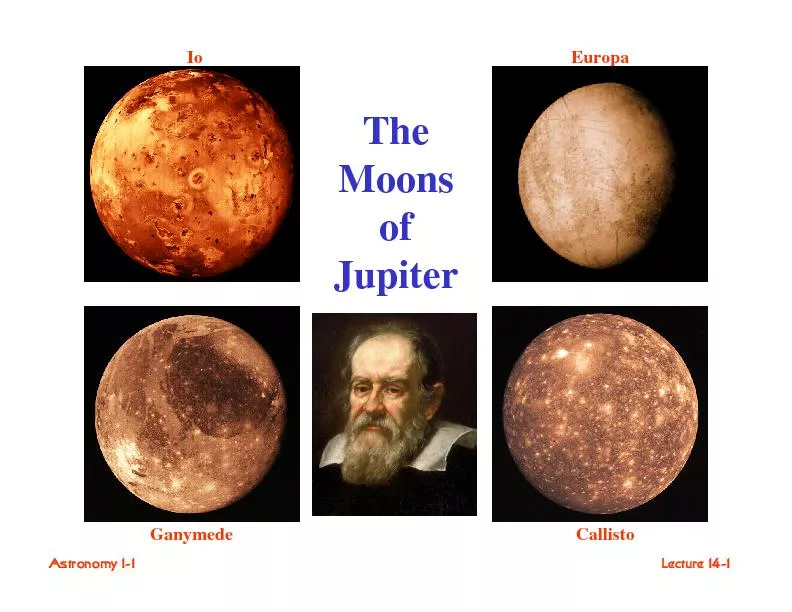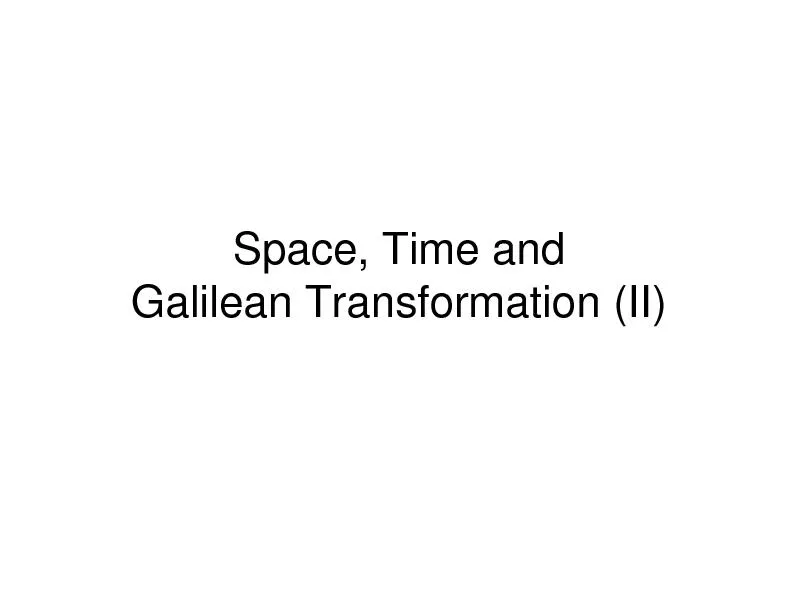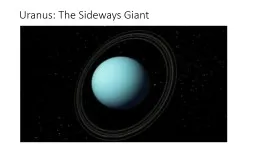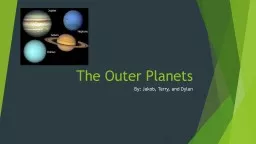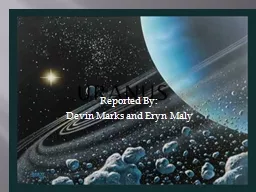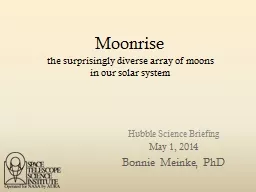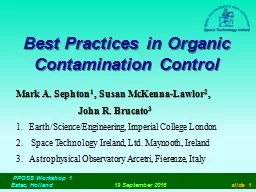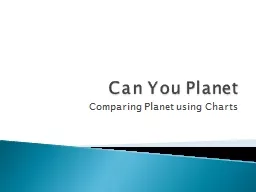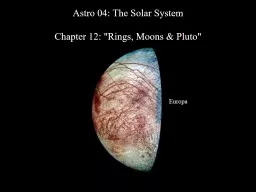PDF-Galilean Moons
Author : sherrill-nordquist | Published Date : 2016-06-08
Io Europa Ganymede and Callisto Discovered by Galileo in 1610 All of these moons are in Synchronous Rotationabout Jupiter The rotation period about each moons axis
Presentation Embed Code
Download Presentation
Download Presentation The PPT/PDF document "Galilean Moons" is the property of its rightful owner. Permission is granted to download and print the materials on this website for personal, non-commercial use only, and to display it on your personal computer provided you do not modify the materials and that you retain all copyright notices contained in the materials. By downloading content from our website, you accept the terms of this agreement.
Galilean Moons: Transcript
Io Europa Ganymede and Callisto Discovered by Galileo in 1610 All of these moons are in Synchronous Rotationabout Jupiter The rotation period about each moons axis is the same as that moons orbit. Saturn Bio/Facts. Diameter: . 116,464 km. Relative Mass (Earth = 1): . 95.2. Density (kg/m. 3. ): . 700. Distance from Sun (AU): . 9.58. Length of Day: . 10.7 hours. Length of Year: . 10,747. days. Mean . The LorentzTransformation ’. s Four Galilean Satellites. The . 4 Galilean . satellites are easily seen. Spacecraft reveal unique properties. Galilean . satellites mimic a planetary system. Io. has abundant volcanic . sulfur compounds. Uranus Bio/Facts. Diameter: . 50,724 km. Relative Mass (Earth = 1): . 14.5. Density (kg/m. 3. ): . 1300. Distance from Sun (AU): . 19.2. Length of Day: . 17.2. hours. Length of Year: . 30,589. days (83 years!). By: . Jakob. , Terry, and Dylan. Jupiter . It is the fifth planet . It is mostly composed of hydrogen and helium . The Great Red Spot is the most famous storm on Jupiter . It is the largest planet . Jupiter’s Moon . Reported By:. Devin Marks and Eryn Maly. Uranus The 7. th. Planet. Sean's Uranus is the 7. th. planet its very cold there.. Uranus is 1.8 billion miles away from the Sun.. Mr. Freeze. Uranus is a freezing planet that means 1. we cant land 2. making it the coldest of the major planets.. Vannatter. , . of the Evansville Vanderburgh Schools. Her . i. ntroduction and discussion of the remarkable life of Galileo can be obtained separately . Deborah.Vannatter@evsc.k12.in.us. Galileo and the moons of Jupiter. Hubble Science Briefing. May 1, 2014. Bonnie Meinke, PhD. the surprisingly diverse array of moons. in our solar system. Inner Solar System. Mercury. 0 moons. Venus. 0 moons. Earth. 1. moon. Mars. 2. Made by Curtis Broomes, Jake Cranswick and Tiana Chifamba. Jupiter is 318 x earth’s mass. . (140,000km across). Jupiter. Our Solar System. What is it made of?. Jupitar is made of hydrogen gas and a little bit of helium, the hydrogen is crushed by its gravity and turned into a hydrogen type liquid. Properties of Space. Three Dimensionality:. If we consider any arbitrary point in space then maximum three perpendicular lines can be drawn from this point. These mutually perpendicular lines are called three axes of the coordinate system. Therefore position of an arbitrary point in space can be defined using three coordinates (x, y, z). So space is three dimensional.. Organic Contamination Control. Mark A. Sephton. 1. , S. usan. McKenna-Lawlor. 2. , . John R. Brucato. 3 . Earth/Science/Engineering, Imperial . College London . . Space . Technology Ireland, . Ltd. . Chapter 8 Moons, Rings, and Plutoids. © 2017 Pearson Education, Inc.. Units of Chapter 8. The Galilean Moons of Jupiter. The Large Moons of Saturn and Neptune. The Medium-Sized Jovian Moons. Planetary Rings. Size. Appearance. Having moons. Having rings. Period of rotation (how long a day is). How Can We classify Planets?. Look at your chart of information.. Approximate Diameter= How Big or small it is.. Period of Rotation = How long fast the planet spins on its axis. . Chapter 12: "Rings, Moons & Pluto". Europa. Callisto. is the outermost of Galilean moons at a distance of 1.2 million miles.. It is in synchronous revolution around Jupiter every 17 days.. . The moon has a heavily cratered surface that has seen little change over the last 4.4 billion years. .
Download Document
Here is the link to download the presentation.
"Galilean Moons"The content belongs to its owner. You may download and print it for personal use, without modification, and keep all copyright notices. By downloading, you agree to these terms.
Related Documents

